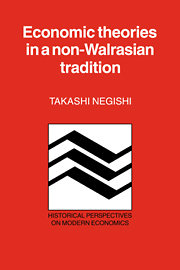Book contents
- Frontmatter
- Contents
- Preface
- 1 Anti-neoclassical or non-Walrasian economic theories
- Part I Increasing returns and diminishing cost
- 2 Adam Smith and increasing returns in a competitive situation
- 3 A reconstruction of Smith's doctrine on the natural order of investment
- 4 The possibility of a falling rate of profit under diminishing cost
- 5 Rehabilitation of Marshall's life-cycle theory to explain diminishing cost
- Part II Wages and profit
- Part III International trade and investment
- Part IV Markets and money
- Notes
- References
- Author index
- Subject index
3 - A reconstruction of Smith's doctrine on the natural order of investment
from Part I - Increasing returns and diminishing cost
Published online by Cambridge University Press: 21 September 2009
- Frontmatter
- Contents
- Preface
- 1 Anti-neoclassical or non-Walrasian economic theories
- Part I Increasing returns and diminishing cost
- 2 Adam Smith and increasing returns in a competitive situation
- 3 A reconstruction of Smith's doctrine on the natural order of investment
- 4 The possibility of a falling rate of profit under diminishing cost
- 5 Rehabilitation of Marshall's life-cycle theory to explain diminishing cost
- Part II Wages and profit
- Part III International trade and investment
- Part IV Markets and money
- Notes
- References
- Author index
- Subject index
Summary
Smith's thesis concerning the different productivities of capital and the associated argument concerning the natural order of investment developed in Books II and III of The wealth of nations are sometimes regarded as being among the less successful parts of the edifice, in comparison with the theory of division of labor and the rudimentary equilibrium theory, both developed in Book I. Smithian arguments to support the hierarchy of productivity of industries, headed by agriculture, followed by manufacture, inland trade, and foreign trade have been subject to severe criticism from many eminent scholars, including Ricardo and J. S. Mill. They are, as a matter of fact, not systematic, not persuasive; rather, they are ambiguous, confusing, and mutually inconsistent (see Kobayashi 1977, ch. 7). Note, furthermore, the fact that the conclusion about the different employment of capital and the natural progress of opulence is reached independently of the division of labor, which, Smith emphasized, has so much to do with the accumulation of capital.
Though it is not successfully proven, however, the theory of the productivity hierarchy is an important and indispensable part of The wealth of nations, since it is employed, in Books III and IV, against the mercantilist policy of favoring foreign commerce and manufacturing, to argue that mercantile policy had diverted capital to less productive uses, with slower returns, than would otherwise have been the case. It is, therefore, not unreasonable to try to reconstruct Smith's arguments rationally by picking up correct fragments and putting them in order.
- Type
- Chapter
- Information
- Economic Theories in a Non-Walrasian Tradition , pp. 23 - 34Publisher: Cambridge University PressPrint publication year: 1985
- 1
- Cited by

